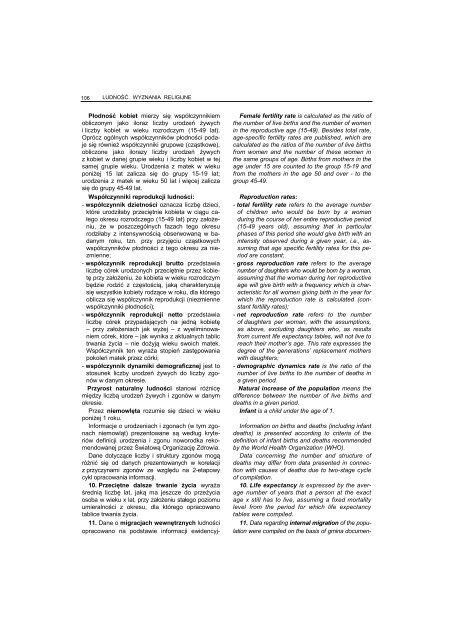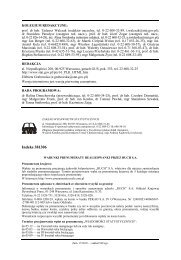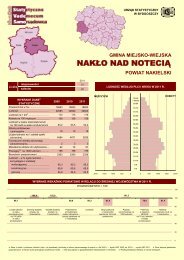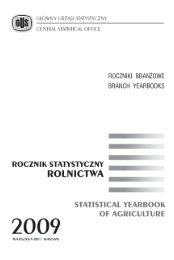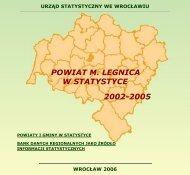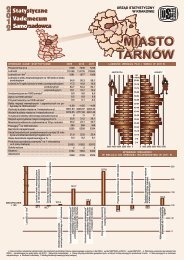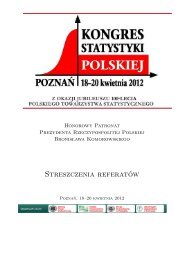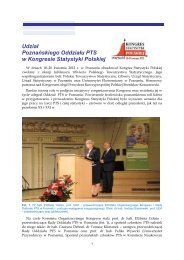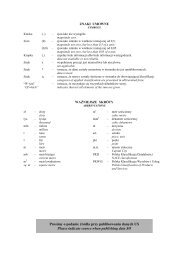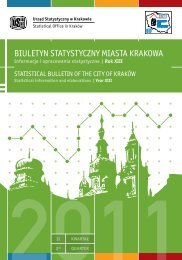Untitled - Główny Urząd Statystyczny
Untitled - Główny Urząd Statystyczny
Untitled - Główny Urząd Statystyczny
You also want an ePaper? Increase the reach of your titles
YUMPU automatically turns print PDFs into web optimized ePapers that Google loves.
106<br />
LUDNOŚĆ. WYZNANIA RELIGIJNE<br />
Płodność kobiet mierzy się współczynnikiem<br />
obliczonym jako iloraz liczby urodzeń żywych<br />
i liczby kobiet w wieku rozrodczym (15-49 lat).<br />
Oprócz ogólnych współczynników płodności podaje<br />
się również współczynniki grupowe (cząstkowe),<br />
obliczone jako ilorazy liczby urodzeń żywych<br />
z kobiet w danej grupie wieku i liczby kobiet w tej<br />
samej grupie wieku. Urodzenia z matek w wieku<br />
poniżej 15 lat zalicza się do grupy 15-19 lat;<br />
urodzenia z matek w wieku 50 lat i więcej zalicza<br />
się do grupy 45-49 lat.<br />
Współczynniki reprodukcji ludności: Reproduction rates:<br />
- współczynnik dzietności oznacza liczbę dzieci,<br />
które urodziłaby przeciętnie kobieta w ciągu całego<br />
okresu rozrodczego (15-49 lat) przy założeniu,<br />
że w poszczególnych fazach tego okresu<br />
rodziłaby z intensywnością obserwowaną w badanym<br />
roku, tzn. przy przyjęciu cząstkowych<br />
współczynników płodności z tego okresu za niezmienne;<br />
- współczynnik reprodukcji brutto przedstawia<br />
liczbę córek urodzonych przeciętnie przez kobietę<br />
przy założeniu, że kobieta w wieku rozrodczym<br />
będzie rodzić z częstością, jaką charakteryzują<br />
się wszystkie kobiety rodzące w roku, dla którego<br />
oblicza się współczynnik reprodukcji (niezmienne<br />
współczynniki płodności);<br />
- współczynnik reprodukcji netto przedstawia<br />
liczbę córek przypadających na jedną kobietę<br />
– przy założeniach jak wyżej – z wyeliminowaniem<br />
córek, które – jak wynika z aktualnych tablic<br />
trwania życia – nie dożyją wieku swoich matek.<br />
Współczynnik ten wyraża stopień zastępowania<br />
pokoleń matek przez córki;<br />
- współczynnik dynamiki demograficznej jest to<br />
stosunek liczby urodzeń żywych do liczby zgonów<br />
w danym okresie.<br />
Przyrost naturalny ludności stanowi różnicę<br />
między liczbą urodzeń żywych i zgonów w danym<br />
okresie.<br />
Przez niemowlęta rozumie się dzieci w wieku<br />
poniżej 1 roku.<br />
Informacje o urodzeniach i zgonach (w tym zgonach<br />
niemowląt) prezentowane są według kryteriów<br />
definicji urodzenia i zgonu noworodka rekomendowanej<br />
przez Światową Organizację Zdrowia.<br />
Dane dotyczące liczby i struktury zgonów mogą<br />
różnić się od danych prezentowanych w korelacji<br />
z przyczynami zgonów ze względu na 2-etapowy<br />
cykl opracowania informacji.<br />
10. Przeciętne dalsze trwanie życia wyraża<br />
średnią liczbę lat, jaką ma jeszcze do przeżycia<br />
osoba w wieku x lat, przy założeniu stałego poziomu<br />
umieralności z okresu, dla którego opracowano<br />
tablice trwania życia.<br />
11. Dane o migracjach wewnętrznych ludności<br />
opracowano na podstawie informacji ewidencyj-<br />
Female fertility rate is calculated as the ratio of<br />
the number of live births and the number of women<br />
in the reproductive age (15-49). Besides total rate,<br />
age-specific fertility rates are published, which are<br />
calculated as the ratios of the number of live births<br />
from women and the number of these women in<br />
the same groups of age. Births from mothers in the<br />
age under 15 are counted to the group 15-19 and<br />
from the mothers in the age 50 and over - to the<br />
group 45-49.<br />
- total fertility rate refers to the average number<br />
of children who would be born by a woman<br />
during the course of her entire reproductive period<br />
(15-49 years old), assuming that in particular<br />
phases of this period she would give birth with an<br />
intensity observed during a given year, i.e., assuming<br />
that age specific fertility rates for this period<br />
are constant;<br />
- gross reproduction rate refers to the average<br />
number of daughters who would be born by a woman,<br />
assuming that the woman during her reproductive<br />
age will give birth with a frequency which is characteristic<br />
for all women giving birth in the year for<br />
which the reproduction rate is calculated (constant<br />
fertility rates);<br />
- net reproduction rate refers to the number<br />
of daughters per woman, with the assumptions,<br />
as above, excluding daughters who, as results<br />
from current life expectancy tables, will not live to<br />
reach their mother’s age. This rate expresses the<br />
degree of the generations’ replacement mothers<br />
with daughters;<br />
- demographic dynamics rate is the ratio of the<br />
number of live births to the number of deaths in<br />
a given period.<br />
Natural increase of the population means the<br />
difference between the number of live births and<br />
deaths in a given period.<br />
Infant is a child under the age of 1.<br />
Information on births and deaths (including infant<br />
deaths) is presented according to criteria of the<br />
definition of infant births and deaths recommended<br />
by the World Health Organization (WHO).<br />
Data concerning the number and structure of<br />
deaths may differ from data presented in connection<br />
with causes of deaths due to two-stage cycle<br />
of compilation.<br />
10. Life expectancy is expressed by the average<br />
number of years that a person at the exact<br />
age x still has to live, assuming a fixed mortality<br />
level from the period for which life expectancy<br />
tables were compiled.<br />
11. Data regarding internal migration of the population<br />
were compiled on the basis of gmina documen-


